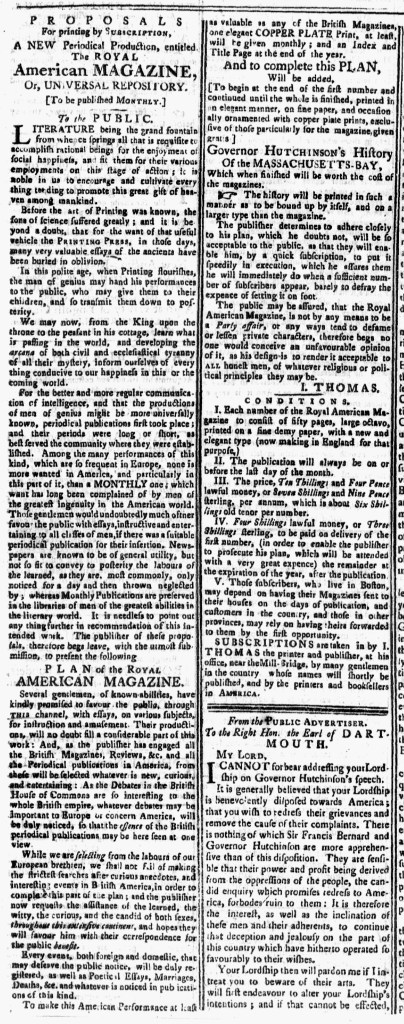What was advertised in a colonial American newspaper 250 years ago today?

“SUBSCRIPTIONS are taken in by I. THOMAS the printer and publisher.”
Near the end of May 1773, Isaiah Thomas, the printer of the Massachusetts Spy, placed a notice in his own newspaper to announce that the following week he would publish “PROPOSALS for printing by Subscription, The ROYAL American MAGAZINE.” He may have meant that he would distribute the proposals as as a broadside or handbill separate from the newspaper or he may have meant that they would appear in the next issue of the Massachusetts Spy. Perhaps he did print separate subscription papers, though none have survived. I frequently argue that newspaper notices provide evidence of a greater number of advertising ephemera circulating in eighteenth-century America than have been preserved in research libraries, historical societies, and private collections. On the other hand, the busy printer may have delayed publishing the proposals by several weeks. When they did appear in the Massachusetts Spy on June 24, they ran on the front page. The savvy printer gave the proposals a privileged place.
Extending nearly two columns, the proposals included Thomas’s purpose for publishing the new magazine, a “PLAN” for the contents, and the “CONDITIONS” or details about the price, the paper, the type, and delivery options. Subscription proposals for books, newspapers, and magazines usually included all those elements, though not necessarily at such great length. Thomas, however, exerted significant effort in convincing readers to subscribe. In explaining his purpose for publishing the magazine, for instance, he declared that “Newspapers are known to be of general utility, but not so fit to convey to posterity the labours of the learned, as they are, most commonly, only noticed for a day and then thrown neglected by.” In contrast, “Monthly Publications are preserved in the libraries of men of the greatest abilities in the literary world.” In the last decades of the eighteenth century, many magazine subscribers in America saved each issue for six months and then had them bound into a single volume to display on the bookshelves of their permanent libraries. Thomas acknowledged how subscribers treated magazines and their specialized content differently than newspapers in that regard.
In outlining the “PLAN,” Thomas described how he would go about acquiring items to publish in the Royal American Magazine. He declared that he “has engaged all the British Magazines, Reviews, &c. and all the Periodical publications in America” and “from those will be selected whatever is new, curious, and entertaining.” He did not intend merely to reprint content from those “British Magazines.” Instead, he emphasized a process of discernment in “selecting from the labours of our European brethren,” but promised prospective subscribers that he “shall not fail of making the strictest searches after curious anecdotes, and interesting events in British America.” To that end, he engaged in an eighteenth-century version of crowdsourcing: “the publisher now requests the assistance of the learned, the witty, the curious, and the candid of both sexes, throughout this extensive continent, and hopes they will favour him with their correspondence for the public benefit.” Although the magazine would carry some European content, Thomas aimed to produce a distinctively American publication.
In addition, Thomas offered a premium or gift to subscribers “to complete this PLAN,” a free copy of “Governor HUTCHINSON’S History Of the MASSACHUSETTS-BAY.” That book alone “will be worth the cost of the magazine.” However, subscribers would not receive a copy at the outset. Instead, they would receive a portion of the book with each issue of the magazine, “printed in such a manner as to be bound up by itself, and on a larger type than the magazine.” Thomas planned to insert the first pages of Hutchinson’s History “at the end of the first number” or issue and continue “until the whole is finished.” To make the premium even more enticing, subscribers would also receive, gratis, “copper plate prints, exclusive of those particularly for the magazine.” Thomas hoped that the free gift would make subscribing to the magazine even more attractive.
Although the subscription proposals for the Royal American Magazine included many of the same elements as proposals for books, newspapers, and magazines that circulated in the colonies in the eighteenth century, Thomas introduced innovative methods of encouraging colonizers to subscribe. Among those, he pledged to make pieces written in America a priority for publication. He also promoted a premium for subscribers, asserting that the free gift alone covered the cost of a subscription. Even with these marketing efforts, it took some time for Thomas to launch the magazine. He published the first issue in January 1774.

[…] three weeks after Isaiah Thomas inserted “PROPOSALS For printing by SUBSCRIPTION, A NEW Periodical Production, entitled, THE ROYAL American MA…,” in his own newspaper, the Massachusetts Spy, those proposals appeared in the July 12, 1773, […]
[…] about what kind of content the publication would feature. On July 29, 1773, he once again ran the subscription proposals as the first item in the front page of his newspaper, the Massachusetts Spy. On the third page, […]
[…] 250 Project has traced the advertising campaign that promoted the Royal American Magazine in June, July, August, and September. An even greater number of advertisements appeared in colonial […]
[…] the forty-three advertisements he published in November. The success of his marketing efforts in June, July, August, September, October, and November likely explains the decline in the number of […]
[…] New Hampshire to Maryland. The Adverts 250 Project has traced his advertising campaign throughout June, July, August, September, October, November, and December 1773 and January 1774. This entry […]
[…] proposals and his advertising campaign undertaken from New Hampshire to Maryland in throughout June, July, August, September, October, November, and December 1773 and January and February 1774 . […]